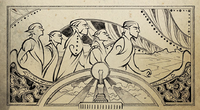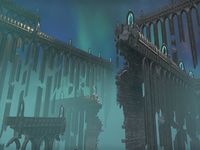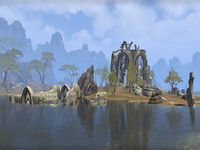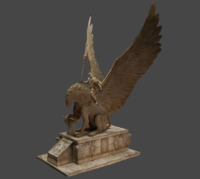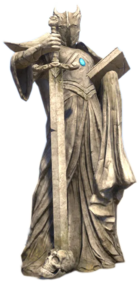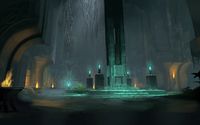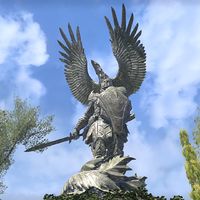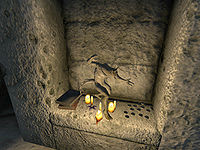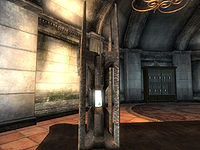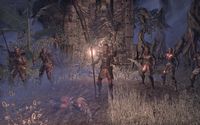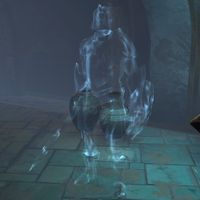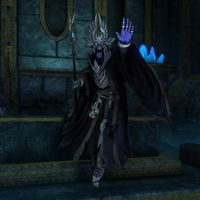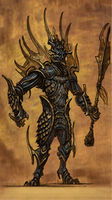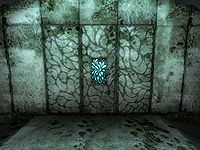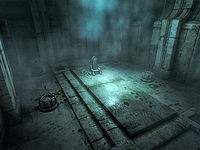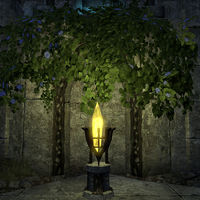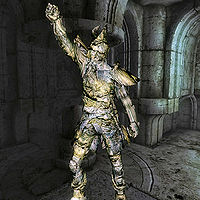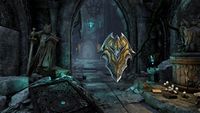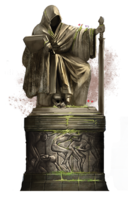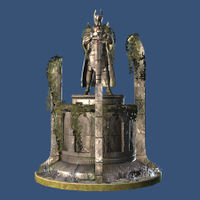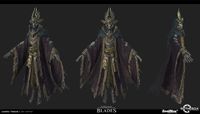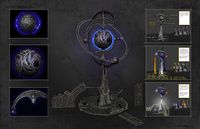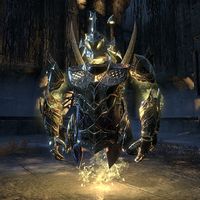Lore:Ayleid
| Ayleids | |||
|---|---|---|---|
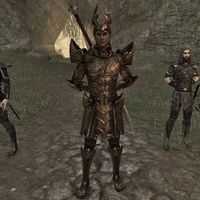 Laloriaran Dynar, the Last King of the Ayleids
Laloriaran Dynar, the Last King of the Ayleids |
|||
| Major Regions | |||
| Historically | Currently | ||
| Cyrodiil | None | ||
| Religion | Daedric Worship (Daedraphile), Eight Divines (Barsaebic) | ||
| Origins | Aldmer | ||
| Descendants | Altmer, Bosmer | ||
| Diaspora | |||
|
|||
—Ayleid phrase[1]
The Ayleids, also known as the Heartland High Elves,[2] Wild Elves, or Saliache,[3] were the first race to establish an empire in Tamriel,[4] and had ruled modern-day Cyrodiil for countless years dating back to before recorded history.[5] They were thin and lean with pointed ears and angular facial features. Their complexion was lighter than that of the Dunmer, but they were darker than Altmer;[6] their skin tone being a light tan to a dark bronze in color and their eyes ranging from white to turquoise.[7]
Ayleidoon, their language,[8][9] is similar to Aldmeris, the ancient language of the Aldmer.[1][10] The Ayleids were the original founders of the Imperial City. They constructed the White-Gold Tower, which they called the "Temple of the Ancestors", in emulation of the Adamantine Tower.[11][12] The Ayleid Empire collapsed in the early First Era when it was overthrown by the Alessian Slave Rebellion.[5] While it's believed that the Ayleids remain in the wilds of every province on Tamriel, sightings have been few.[4] There have been no known sightings in the Third or Fourth Eras.
History[edit]
Merethic Era[edit]
- "Wear lore as your armor."[1]
The Ayleids began as groups of Mer who left the Summerset Isles to create splinter cultures in central and southwest Tamriel.[13] The first left in the Middle Merethic Era, after the area had been charted by Topal the Pilot and others,[14][15][16] In some cases, they left specifically to evade the strictures of Aldmeri regulation, which forbade (among many other things) the worship of Daedra.[13] The Ayleids were in High Rock as early as the First Era,[nb 1] and their ruins can be found throughout the province, including the Wrothgarian Mountains and as far as the island of Betony.[17][18]
Though they settled predominantly in Cyrodiil, the Barsaebic Ayleids also had settlements in modern-day Black Marsh. The Ayleid rulers of Black Marsh were renowned as necromancers and titled the Fenlords.[19] The cities Gideon and Stormhold were originally Ayleid settlements whose names have been lost to history.[20][21] The earliest Aldmeri account of the Heartlands of Cyrodiil from Topal the Pilot speaks of friendly feathered Bird Men who resided there,[22] but these natives disappeared from history, only to be replaced by the Ayleids. It is also alleged that the Bird Men were enslaved by the Ayleids.[23]
Far away from Alinor, Ayleidic culture flourished. In the last millennium of the Merethic Era, Daedra worship took hold and spread among the Heartland High Elves. The cults devoted to the various Daedric Princes which had sprung up across Cyrodiil, once merely tolerated, became celebrated.[13] Unlike the Chimer who left Summerset in the Late Middle Merethic Era,[14][24] the Ayleids made no distinction between "good" and "bad" Daedra. Even some of the more heinous Princes received mass veneration, especially when their worship was adopted and endorsed by Ayleid kings and aristocrats.[13]
The Ayleids made deals with Daedra for more power, blessings, and other advantages.[25][26] They employed entire armies of Daedra to conquer, subjugate, and enforce their rule.[2][27] In the earliest Cyro-Nordic stories, Shezarr fought against the Ayleids on mankind's behalf, then vanished, presumably to go help humans elsewhere. Without his leadership, the Cyrodiils were dominated and enslaved by the Ayleids.[28] At first this enslavement of the Nedic peoples was occasional, but eventually this became a systematic, widespread institution of Ayleid society.[13] They eventually controlled the entirety of modern-day Cyrodiil, and kept the Nedic peoples there enslaved for generations.[29] The Ayleids are also said to have enslaved beastfolk.[23]
The fortress of Ilayas was built on a seaside hill of Malabal Tor, in the province of Valenwood, many years into the Merethic Era, and it was also active during the golden years of the Ayleid Empire, roughly between ME 850 and ME 900. The Ayleid lords of Ilayas were part of an ancient order of lightning wizards called the Stormwardens, who defended the coast from foreign invasion and operated an Ayleid artifact called the Sphere of Storms, a potent orb that utilizes weather magic to manipulate the waves of the coast and supply water for crops.[30]
In the late Merethic Era, at the height of Ayleid rule, Abagarlas was a wealthy city which prospered on account of its large population of mercenaries.[31] Located close by was the city of Delodiil, which was home to a glorious temple dedicated to the worship of Meridia, the Lady of Light. Growing envious of Delodiil's temple, King Anumaril of Abagarlas ordered the construction of a far more massive temple dedicated to Molag Bal. Although Anumaril's temple dwarfed Delodiil's, its design was crude and aesthetically displeasing, leaving Delodiil's people, including their king, Cenedelin, unimpressed. Hearing of Delodiil's dismissal of his temple enraged King Anumaril, and after profaning Abagarlas' small shrine to Meridia, he ordered the destruction of Delodiil and proclaimed that he would sacrifice its populace to Molag Bal.[31] Anumaril, calling upon his dark master, was granted an army of undead and the knowledge to construct a weapon known as the Mortuum Vivicus, which would drain all life from Delodiil, and convert its citizens to undead servants of Molag Bal.[32] Meridia, knowing of Molag Bal and Anumaril's twisted plans, warned her subjects in Delodiil, and in response a small group of priests were dispatched to Abagarlas to destroy the weapon. Upon reaching Abagarlas the priests tore a bloody swath through the city, putting both Anumaril's wife Queen Palolel and his son Prince Malyon to the sword. Soon, the priests successfully reached the Mortuum Vivicus, in time to stop the contraption's activation. However, Molag Bal pulled the device into Coldharbour before it could be entirely destroyed. After the priests fled the city, undead in tow, Meridia completely destroyed the city through divine lightning.[33]
The Narfinsel Schism was a civil conflict that spanned the Late Merethic Era to 1E 198. The war was held between the Aedra and Daedra-worshipping Ayleids of Cyrodiil. The war's conclusion, brought in by the Scouring of Wendelbek, marked the end of any organized resistance to Daedra-worship in Cyrodiil. The lasting effects of the Schism were theorized to have greatly contributed to the fall of the Ayleid Empire and the White-Gold Tower, nearly half a century later.[34][35]
First Era[edit]
In the First Era, together with his undead forces, the immortal Celemaril Light-Bringer waged war across Tamriel.[36] His brother Valentis led other Ayleid kings in a rebellion against Celemaril. With varla stones and an Elder Scroll, Valentis donned Celemaril's crown and spoke a ritual incantation, sealing his brother within a crypt beneath a marble statue bearing his likeness.[37] As king, Valentis would then erase much of the records of Celemaril and his conquest.[36] Valentis also founded the town of Rivercrest around his statue which sealed Celemaril.[38]
At some point prior to the Alessian Slave Rebellion, a clan of Barsaebic Ayleids led by an Ayleid mage known as Myndhal invaded the region of Murkmire in southern Black Marsh in order to steal the souls of the native Argonians The Ayleids launched a series of attacks on the Root-Whisper Tribe. The tribe was unable to resist the invaders, forcing the tribe's Hist tree to take a drastic measure: the creation of a "seed", an amber gem which would later be known as the Remnant of Argon, which was capable of holding the souls of the tribe, preventing the Ayleids from harvesting them. In this way, the Hist planned to preserve its tribe and become dormant, only to be awakened when the Ayleid threat to Murkmire was ended.[39][40] Upon learning of the Remnant's creation, and having failed to secure it during its formation, Myndhal attempted to locate it by any means necessary in order to make use of its power. An Ayleid mage named Houtern began to construct Welkynd-powered Nexus Gates that all connected to Eld Angavar to traverse Murkmire in search of the Remnant. Over time, this resulted in the creation of a "golden path", a sea of azure gates linking to one another within an otherwise-empty void. However, the Ayleids were ultimately unsuccessful in their search, and were forced to turn to Argonian technology to locate the Remnant.[41][42] Through the use of Argonian vakka stones, Myndhal theorized that he could create a link to wherever the Hist had hidden the Remnant, and swore to find a way to it even if it would take "hundreds of years". In 2E 582, the Vestige traversed Eld Angavar and killed Myndhal, who had become undead and seemed to still be working on a way to uncover the Remnant.[41]
Alessian Slave Rebellion[edit]
The example of the Nords to the north inspired the Alessian Slave Rebellion of 1E 242.[43] Alessia's rebellion coincided with a civil war within the Ayleid Empire which led to many rebel Ayleid lords joining forces with Alessia and aiding her rebellion.[5][44] These allies of Alessia were largely Aedra-worshippers,[13] indicating that the schism among the Ayleids was likely related to religious differences.
Skyrim, of course, lent help to their enslaved relatives under the Ayleid Empire, which also played a part in the Ayleids being overthrown.[45][46] In only a year, the Slave Queen Alessia and her supporters had taken the White-Gold Tower, founded the Alessian Empire, and secured the subsequent shift in power from mer to men on Tamriel.[45][15]
Sometime after the Alessian Slave Rebellion,[47] various Ayleid kingdoms launched a desperate search for the fabled Wrathstone, a weapon that they believed would be their salvation against the encroaching forces of the Alessian Empire. An expedition marched to the Dwemer city of Mzulft, in the hold of Eastmarch in Skyrim, where it was rumored the Wrathstone was held. The Ayleids besieged Mzulft, but failed to breach it or retrieve the artifact.[48] At the time, the Ayleids were unaware that the Dwemer only possessed the left half of the Wrathstone, and that half was stored not at Mzulft, but at nearby Kagrenzel.[48] After the failure of the raid on Mzulft, Meridia appeared to her faithful with a cryptic warning that the Ayleid Empire would soon fall, and entrusted the right half of the Wrathstone to Garlas Malatar and King Narilmor. To keep his piece of the Wrathstone safe,[47] Narilmor denied both aid and asylum to the desperate Ayleid refugees from other kingdoms, and locked them out of his city.[49] The inhabitants of Garlas Malatar were not heard of again. Although Garlas Malatar was eventually besieged by Men, some accounts have suggested that the attackers did not even make it inside Narilmor's city before it collapsed into ruin; it was speculated that the city fell from within, brought down by internal conflict or sabotage.[49]
The Late Ayleid Period[edit]
- "Our exiled Elven ancestors heard the welcoming gifts of peace in the streams and beech trees and stars."[1]
The Alessian Slave Rebellion was devastating to the Ayleids. Legend says entire settlements were slaughtered at the hands of Alessia's champion, Pelinal Whitestrake.[9] Though the Ayleids would continue to have a presence in Cyrodiil for several hundred years, the fall of the White-Gold Tower in 1E 243 signaled the beginning of the Late Ayleid Period and the start of the Ayleid Diaspora. The Temple of the Ancestors was turned into the Imperial Palace by Alessia and her descendants, and it remains so to this day. The Bravil region was one of the very last areas to be liberated by the Alessian army. It took Alessia's forces, led by Bravillius Tasus, four attempts to finally defeat them.[50] In these early years, the Alessian Empire forbade the worship of the Daedric Princes and focused on hunting down and exterminating Daedra-worshipping Ayleids.[13]
Ayleidic culture lingered in the Aedra-worshipping city-states that survived as client kingdoms of Alessian Cyrodiil, but resentment at the continued presence of Ayleid nobles within the Empire was a contributing factor to the rise of the so-called Alessian Order founded by Marukh. In 1E 361, the Alessians gained control of the Empire and enforced the Alessian Doctrines throughout its domain. The Ayleid lordships were abolished. Enforcement of this decree does not appear to have required much direct violence — it seems that by this point the balance of power was so overwhelmingly against them, and their fate so long foreshadowed, that most of the remaining Ayleids simply left Cyrodiil to join the Ayleid Diaspora, eventually being absorbed into the elven populations of Valenwood and High Rock.[5][51] Some Ayleid clans were known to have settled in the Wrothgarian Mountains.[52] It's speculated that the exodus of the Ayleids from Cyrodiil may have vastly strengthened the Direnni Hegemony in High Rock - in which case, the Ayleids had their revenge, as the war with the Direnni eventually crippled the Alessian Empire and brought about its fall.[5][53]
The only known Ayleids who remained in Cyrodiil served as mentors and tutors for the new human nobility.[54]
In the years 1E 372-374, King Dynar was given an ultimatum by the Alessian Emperor. He and his people were eventually forced to abandon Nenalata and flee to High Rock in order to escape the anti-Ayleid pogroms.[55] During their exodus, hunters among the Nenalata Ayleids used senche mounts daily to track and kill game to help feed the evacuees. [56] In High Rock, King Dynar and his people were welcomed by the Direnni clan. After displacing previous Orc residents, they settled on the shores of the Halcyon Lake. There, King Dynar founded the new city of Bisnensel, which was a miniature copy of Nenalata.[55][57]
In the years 1E 453-460, the Primeval Seekers, a cult devoted to Hermaeus Mora, was formed in Bisnensel. Their leader, High Priest Uluscant, demanded more of a say in municipal affairs as the cult grew in power. King Dynar denied these demands. As a result, after a few months Dynar was deposed and forced to flee from Bisnensel.[55][57] King Dynar and his family fled to Balfiera, where they were granted asylum among the Direnni. Later, Dynar became a highly regarded tactician and strategist in the Direnni army.[55]
In the late 400s, the Alessian Order invaded High Rock. The invasion culminated in the great Battle of Glenumbra Moors, in which King Dynar participated.[55][5] The battle was won by the Direnni and was a fatal blow to the Alessian Order.
In the years 1E 482-484, King Dynar returned to the Heartland and was lured to Nenalata, where he fell into Molag Bal's trap and was imprisoned in Coldharbour, in a replica of the White-Gold Tower.[55] There he remained for over three thousand years, until he was freed.[58] Other sources state that King Dynar was not captured by Molag Bal in Nenalata, but instead was present in the Hollow City while it was still in Cyrodiil, was pushed into Coldharbour along with it, and captured shortly afterwards.[59]
It is possible that some tribes of Ayleids may continue to live deep within the forests of Cyrodiil even into modernity, yet the most recent reported sightings (as of the Late Third Era) are more than 1000 years old.[4][6] These Ayleids, or Wild Elves, are at best a rarity and may not have actually survived into modern times.
Legacy[edit]
Second Era[edit]
In the year 2E 582, King Dynar was finally freed by the Vestige, who infiltrated Coldharbour with the Fighters and Mages Guilds in an effort to stop Molag Bal's terrible Planemeld. The Ayleid king assumed command over the Fighters Guild forces, who had been leaderless after their captain had been slain. The invasion force, led by the Vestige and aided by Meridia, eventually managed to stop the Planemeld inside the Planar Vortex, but King Dynar was mortally wounded while trying to close a Daedric portal. He died soon afterwards in the Hollow City, in Meridia's Chapel of Light.[60] His spirit is believed to have gone to Aetherius.[61][62]
King Hadhuul's spirit, along with spirits of his army and some Flame Atronachs, reappeared at Ceyatatar during the Planemeld in 2E 582, but these invaders were banished by soldiers fighting in the ongoing Alliance War before they could harm the nearby settlement of Vlastarus.[63]
Around 2E 283,[64] an entire Imperial expedition from Fort Mistwatch was forcibly converted into Meridian Purified when they uncovered the power hidden within Garlas Malatar, serving as unwilling protectors of the Wrathstone.[65] In 2E 582, the treasure hunter Tharayya accompanied by the Undaunted uncovered the horrors that took place in Garlas Malatar. The expedition fought off hordes of the Meridian Purified who attempted to convert them, and encountered King Narilmor, who had by then had guarded the Wrathstone for three thousand years.[66] They slew him but he was then transformed into the Symphony of Blades, an avatar of Meridia's power, in the image of an Auroran suit of armor with four arms and blades. He teleported the Undaunted to the Colored Rooms where he was empowered. It wasn't enough to overpower the expedition, and he was slain. Tharayya successfully retrieved the right half of the Wrathstone as a result.[67]
Roughly around 2E 582, an Ayleid ruin known as Hecul was discovered by a procurement organization known as the Velothril Sisters. They employed several bounty hunters to loot the ruins, but all of them perished.[68] A former procurer of theirs, Valyne Hlan, eventually discovered that a curse, speculated to be Daedric in origin, had been placed on the ruins so that those who attempted to uncover its secrets would repeatedly mutter or write down the phrase "abavarlor" until they were driven to suicide or other means of death.[69] This was presumed to be the reason that the ruin was also known as "Outcast" even among the Ayleids.[70]
Third Era[edit]
In 3E 433, the crown of King Dynar (whose name had apparently become forgotten by then) was in possession of an Imperial scholar of the Ayleids named Herminia Cinna. A rival collector named Umbacano sent the Hero of Kvatch to obtain the crown, which he wanted to use to transform himself into the King of Nenalata and restore Ayleid civilization by raising an undead army within Nenalata. Cinna, however, did not want to sell it, instead hoping to trick Umbacano into accepting the Crown of Lindai. It is unknown which crown the Hero chose to deliver to Umbacano. Regardless, Umbacano was killed later that year during an expedition to Nenalata.[71]
Fourth Era[edit]
In 4E 180, the Bloodfall Queen's hired mercenaries were sent to collect taxes from the town of Rivercrest, because they refused to pay expensive taxes. Things soon escalated between the citizens of Rivercrest and the hired mercenaries, and in response the hired mercenaries destroyed the town's Elder Statue. The destruction of the town's Elder Statue caused the undead Ayleid Sorcerer-King Celemaril Light-Bringer to be released from his ancient bindings in the Ayleid ruins beneath the town, and the Warrior set out to rebuild the town and save all of Tamriel from the reawakened Lich. To rebind the Lich, the Warrior retrieved Celemaril's crown, five varla stones, an Elder Scroll, and a stone tablet inscribed with the ritual incantation. By the time the Warrior had acquired the necessary knowledge and items, Celemaril had amassed another undead army. He launched a final assault upon Rivercrest as the Warrior fought one-on-one against the Sorcerer-King. The Warrior was victorious and sealed Celemaril beneath Rivercrest once more.[72]
Society[edit]
- "In the caverns of lore, ugly and obscure, shines the gold of truth."[1]
Ayleidic society was an alliance of kingdoms united under one empire, which ultimately ended in 1E 243 with the death of their champion, Umaril the Unfeathered, and the fall of the White-Gold Tower.[4]
The impact of the loss of the Ayleids' tower, what they called the "Temple of the Ancestors", should not be underestimated. They had built it in emulation of the Adamantine Tower,[12] and made the Chim-el-Adabal, which they believed to be the crystallized blood of the Heart of Lorkhan, into the tower's Founding-Stone.[73] It is the site where the Ten Ancestors, statues sacred to the Ayleids, were traditionally held. They were spread to various other settlements during the siege of the White-Gold Tower for safekeeping, but were not reunited again until the late Third Era, long after the fall of the Ayleids.[11][25]
Ayleids frequently adorned themselves with feathers and magic beads.[9] They are said to have been "obsessed" with the number eight (which may have been why the pantheon Saint Alessia created was made up of Eight Divines).[29]
Most humans, at least, agree that the Ayleids' fall from power, if not their extinction, is for the better, as the portrayals of them passed down by their former slaves are not kind. Their scholars label the Ayleids as bellicose and arrogant, and point to this being the ultimate reason for their downfall.[26][43][44] Slaves were utilized by the Ayleids for a variety of purposes, including agricultural work, entertainment, and the building and maintenance of their empire's infrastructure. According to legend, the Ayleids literally turned cruelty into an art form, and many Daedra-worshipping Ayleids across Cyrodiil derived strange pleasures from "art-tortures".[29][13]
Typically, Ayleid kingdoms where the most malevolent Daedric Princes were worshipped also proved to exhibit the worst treatment of their slaves.[13] Various settlements became famous for their particular, elaborate method of torturing their slaves, such as "wailing wheels", "gut gardens", "flesh-sculptures", and forced ingestion of hallucinogenic drugs, as well as nighttime "tiger sport", which involved the immolation of human children.[29]
As the kingdoms of the Ayleids dwindled, they apparently adapted to a more rural, elusive, and possibly nomadic lifestyle. Any remaining Ayleids are unknown; if they continue to exist, they are likely living in hiding. The Ayleid Sage Tjurhane Fyrre (1E 2790 - 2E 227) talked and wrote extensively of the state of the Ayleids' culture. According to Fyrre, the Ayleids of his time lived in a tribal society, with each "tribe" being substantially different from the next.[4] The Ayleid settlements in modern-day Black Marsh were particularly far removed from the culture of the heartlands, and were never attacked by the Alessian armies.[20] It's not clear how these settlements met their fate.
Magic[edit]
Magic was an enormous part of their society. In accordance with High Elf religion, they believed Nirn was composed of four basic elements: earth, water, air, and light (as opposed to the four elements of modern natural philosophy: earth, water, air, and fire).[74][75] Some of their magic tapped into the power of the weather.[25] The most sublime form was starlight, as the stars were the link between Mundus and Aetherius.
They used aetherial fragments which fell from the heavens, particularly meteoric iron, to construct receptacles which are believed to harness energy from starlight. These "Ayleid Wells" are scattered all over Cyrodiil, and can still be used by mages to replenish their energy. The logic used in their placement is a mystery, and none are known to be associated with any particular Ayleid settlements. They kept specially cut pieces of meteoric glass known as Welkynd Stones (meaning literally "sky children") as storage containers for magical energy, as well what are called Varla Stones (or "star stones").[75] This was still an emerging technology when the Alessian Slave Rebellion brought about the decline and disappearance of their society.[76] Some of these crystals had the capacity to store and release memories directly to the reader; overuse of these crystals can cause a 'problem of capacity' for mortals.[77] Varla gems were occasionally used to imbue the diadems by Barsaebic for that purpose.[78]
They preserved many of the ancient runes and Dawn Era magics of the Ehlnofey that other elves had forgotten.[14][79] They also developed what came to be called the school of Alteration, as they were skilled in magics such as shapeshifting and levitation.
Architecture[edit]
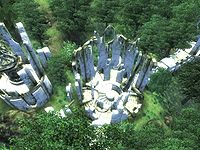
Much like how the ruins of the lost Dwemer dot Hammerfell, Skyrim, and Morrowind, the Ayleids have left ruins scattered around Cyrodiil and other regions which were once under the dominion of their Empire. These underground cities can prove deadly for adventurers, hiding such dangers as traps, monsters, undead, and criminals. Their cities were amazing feats of architecture ranging from small settlements to gigantic, labyrinth-like metropolises shaped out of whitish rock.[25][80] They also seem to have had a firm grasp of the magical arts, as many of their ruins contain stones filled with magicka essences harvested from the sky. They also developed what came to be called the school of Alteration, as they were skilled in magics such as shapeshifting and levitation.[74][75][50][6]
The prophecies of the moth-eyed foretold that Ayleidic hubris would "bear bitter fruit",[73] a warning that many, apparently, failed to heed. It would be their undoing.
Religion[edit]
Aedra[edit]
Few blanket statements can be made about Ayleidic religion. They began as splinter groups, and they were never totally united in their beliefs.[13] But while they are most well-known to historians for being "godless" and "Daedra-loving",[81] their society was fundamentally dedicated to the veneration of the Aedra, not the Daedra, until the last millennium of the Merethic Era.[31]
Even after the Daedric cults rose to power (discussed above), many Ayleidic kingdoms continued to honor the Aedra.[13] Many slaves in Cyrodiil became Aedra-worshippers by adopting many of the beliefs of their masters,[2][28] and it's suspected that Alessia incorporated elven Aedra into her Eight Divines pantheon in order to appease her Ayleid and Ayleid-influenced vassals.[13] Ayleids venerated their ancestors,[11] and Aedra is an Elven word for "ancestor".[82]
Auri-El[edit]
Auri-El was known to be worshipped by the Ayleids.[11] Ayleid statues of Auri-El throughout Cyrodiil depict an eagle lifting up a figure carrying a bow and shield from the ensnaring ground.[25][83]
Magnus[edit]
Magnus was worshipped by some Ayleids as the God of Sight, Light, and Insight and were known to have dedicated temples in his name.[74][83]
Mara[edit]
Stendarr[edit]
Trinimac[edit]
Xarxes[edit]
Y'ffre[edit]
Daedra[edit]
Blood-Made-Pleasure[edit]
To the Ayleids, Sanguine was known as the Blood-Made-Pleasure.[84] Those from the kingdoms that worshipped the more malevolent Daedric Princes were known to indulge in the pleasures of art-torture, such as flesh-sculpting and gut-gardening.[13] An ancient Ayleid manuscript of Eldhaal the Inducer describes him being overseen and guided by Sanguine in these heinous arts, particularly in the creation of the "Messenger Beast Redeemed".[84]
Hyrma Mora[edit]
The city of Bisnensel began to worship Hyrma Mora under the lead of High Priest Uluscant, who established a congregation in Bisnensel that attracted many of the learned and most influential people in the community. As their numbers became more numerous, on their behalf Uluscant requested more of a say in municipal affairs, a request that was denied by King Dynar. Within a few months of his rebuff, Dynar was deposed.[85] The Ayleids of Bisnensel turned the city into a shrine and stored forbidden knowledge of the natural order, which could allow one to manipulate the very fabric of reality.[86]
Mehrunes Dagon[edit]
In ancient times, Dagon created a construct known as the Nefarivigum to challenge those who drew near to undertake a trial. One who passed the trial would be deemed worthy of wielding Mehrunes' Razor. Located in Cyrodiil, the Nefarivigum was discovered by the ancient Ayleids, who arrogantly believed they could turn away any who sought the Razor. To this end, they built the vast, ringed city of Varsa Baalim during the height of Ayleid civilization. For many years, pilgrims came to Varsa Baalim seeking the Razor, but the Ayleids turned them away. One day in the early years of the First Era, a vampire infiltrated the city. Before long, the city was infested with undead and thrust into chaos. The city suddenly and mysteriously disappeared. None know what happened, but Varsa Baalim seemingly vanished into the mountains of the Eastern Nibenay Basin.[26]
Mephala[edit]
The Ayleid city of Erokii was ruled by princess Anurraame, whose wisdom, grace, and beauty were unsurpassed. She married a prince from another state, and their relationship was happy for a time. However, Anurraame's husband was away for extended periods of time. The princess's passion died, and she took a younger warrior as her lover. Her husband eventually caught wind of the affair, and gathered his army to storm the city. Anurraame pledged to face him in battle, and her lover promised to muster his own forces in defense of the city. When the day of the battle arrived, Anurraame saw that her lover had betrayed her for a bribe, as his legions had joined her husband's. The spurned princess called upon the Daedra to help defend her city, and Mephala answered her plea. She commanded Anurraame to pour all her tears in a basin, then imbued them with the power of Anurraame's hatred for her traitorous lover, which was only strengthened by the genuine love she had for him before he turned on her. Her tears hardened into a powerful artifact known as the Tears of Anurraame, which the princess used to destroy both armies and her city in the blink of an eye.[87]
Merid-Nunda[edit]
Merid-Nunda (known as the Bright One and Rainbow of Light)[88] was an extremely important figure for the Ayleids, as she was considered the personification of their fourth element, light.[89] The Ayleids often depicted Meridia with wings and a cowl.[90]
Merid-Nunda was the patron deity of Garlas Malatar, a city which was built upon the Gold Coast. Its ruler, King Narilmor, was a devout worshiper of Merid-Nunda who dedicated his life and city to her veneration. He was considered a favorite of the Daedric Prince, second only to her champion, Umaril the Unfeathered. She gifted the city with a relic known as the Guiding Light, which shone above the city with her unquenchable light. It was a literal and metaphorical beacon, visible for great distances.[49]
She is remembered by the Imperials as a patron and mentor to the Heartland High Elves, and complicit in the bondage and oppression of their ancestors.[91]
Mola Gbal[edit]
Molag Bal was known as Mola Gbal to the Ayleids,[92] and was the patron deity of Abagarlas.[31][93]
King Anumaril of Abagarlas was granted an army of undead and the knowledge to construct a weapon known as the Mortuum Vivicus, which would drain all life from Delodiil, and convert its citizens to undead servants of Molag Bal.[32] Meridia, knowing of Molag Bal and Anumaril's twisted plans, warned her subjects in Delodiil, and in response a small group of priests were dispatched to Abagarlas to destroy the weapon. Upon reaching Abagarlas the priests tore a bloody swath through the city, putting both Anumaril's wife Queen Palolel and his son Prince Malyon to the sword. Soon, the priests successfully reached the Mortuum Vivicus, in time to stop the contraption's activation. However, Molag Bal pulled the device into Coldharbour before it could be entirely destroyed. After the priests fled the city, undead in tow, Meridia completely destroyed the city through divine lightning.[33]
Other[edit]
A deity whose name was lost to history, known only as the Insect God, was venerated by Flower King Nilichi. The Nedic Men-of-ge were eventually "destroyed" when the Flower King made a great sacrifice to this long-forgotten insect god.[29]
The Ayleid Diaspora was allowed to settle in Valenwood on the condition of adopting aspects of the Green Pact. Having little choice, the Ayleids agreed and refrained from harming the forest, which probably contributed to the dilution of their culture and their eventual integration with the local Bosmer population.[34]
The Ten Ancestors are a set of ten Ayleid statues. They consist mostly of meteoric iron prongs, with a shard of meteoric glass in the center. The statues played an important role in Ayleid religion and were displayed in the Temple of the Ancestors, now known as the White-Gold Tower. The temple of Loriasel was also built in Black Marsh by the Barsaebic Ayleids in veneration of the Ancestors.
The Ancestors themselves were believed to worship the Daedra, and Daedraphile Ayleids accordingly followed the Eleven Edicts of the Ten Ancestors. The Heretic of Lindai was known for writing the Eleven OTHER Edicts of the Ten Ancestors, a parody that supposed the Ancestors worshipped Auri-El instead.
Gallery[edit]
-
An Ayleid memory crystal in Ilmyris (ESO)
Notes[edit]
- Ayleid Revivalists are said to be a secret society who wish to see the rise of the Ayleids once more.[94][11]
- The reason Ayleids were initially referred to as uncivilized "wild elves" is because they were originally intended to be encountered as enemies in Daggerfall, who could be non-hostile to players fluent in elvish, before they were cut from the game.[95]
See Also[edit]
- Ayleid Names
- Ayleidoon
- For a list of notable Ayleids, see here.
- For game-specific information, see the Oblivion, Elder Scrolls Online, Legends, and Blades articles.
- For a list of Ayleid ruins which appeared across games, see the Lore article, or the game-specific Oblivion and ESO articles.
Books[edit]
- The Adabal-a by Morihaus — The memoirs of Morihaus, consort to Alessia and Taker of the Citadel
- The Amulet of Kings by Wenengrus Monhona — Chronicles the creation of the Amulet of Kings
- The Annotated Anuad — Early religious book providing a simplified version of The Anuad creation myth from the Mythic Era (described by some sources the "Ayleidish" creation myth)[96]
- Ayleid Survivals in Valenwood by Cuinur of Cloudrest, 4th Tier Scholar of Tamrielic Minutiae — Thalmor report on the Ayleid Diaspora in the First Era
- Bisnensel: Our Ancient Roots by Scholasticus Incognitus — The tale of Bisnensel, one-time kingdom of the Last King of the Ayleids
- Daedra Worship: The Ayleids by Phrastus of Elinhir — A description of Daedric worship by the Ayleids
- Daughter of the Niben by Sathyr Longleat — The history of Bravil and its famous statue of the Lucky Old Lady
- Exegesis of Merid-Nunda by Phrastus of Elinhir — Thoughts on a rare manuscript
- Glories and Laments by Alexandre Hetrard — The "glories" of the Ayleid city Ceyatatar and "laments" over the collapse of the Ayleid civilization
- The Ivory Lord: A Hero Born — The tale of Erric Deleyn, a High Rock hero against the Alessian Empire
- The Last King of the Ayleids by Herminia Cinna — Chronicles the downfall of the Ayleid Empire in the First Era
- A Life of Strife and Struggle by King Laloriaran Dynar — Notes for the personal memoirs of King Laloriaran Dynar, "Last King of the Ayleids"
- Magic from the Sky by Irlav Jarol — Treatise concerning Ayleid Wells, Welkynd Stones, and Varla Stones
- Pocket Guide to the Empire, 3rd Edition by the Imperial Geographical Society — An illustrated guidebook detailing the provinces of the Empire, circa 3E 432
- Shezarr and the Divines by Faustillus Junius — The relationship between the god Shezarr and the other Cyrodilic deities
- The Tale of Princess Anurraame — A short story of an Ayleid princess
- Tears of Anurraame — The tale of an Ayleid princess
- Telquelie, scholar of Ayleid history by Telquelie — A scholar's notes on the downfall of the Ayleids
- Treatise on Ayleidic Cities — The history of Varsa Baalim and Mehrunes' Razor
- The Whithering of Delodiil by Unknown — An Ayleid legend surrounding the rivalry between two cities and their Daedric patrons
- The Wild Elves by Kier-Jo Chorvak — Brief description of the Ayleids, or Wild Elves
References[edit]
- ^ a b c d e Ayleid Reference Text — Raelys Anine
- ^ a b c The Amulet of Kings — Wenengrus Monhona
- ^ The Onus of the Oghma — Phrastus of Elinhir
- ^ a b c d e The Wild Elves — Kier-Jo Chorvak
- ^ a b c d e f The Last King of the Ayleids — Herminia Cinna
- ^ a b c 2920, Second Seed — Carlovac Townway
- ^ Appearance of Queen Palolel, Myndhal, and various Ayleids
- ^ The Vanishing Crux — Masura-dra, Sentinel Magister
- ^ a b c The Song of Pelinal
- ^ Butcher Journal 2 — The Butcher
- ^ a b c d e Umbacano's dialogue in Oblivion
- ^ a b Beacon of Tower Zero furnishing name, appearance and Codex entries in ESO
- ^ a b c d e f g h i j k l m Daedra Worship: The Ayleids — Phrastus of Elinhir
- ^ a b c Before the Ages of Man — Aicantar of Shimerene
- ^ a b Pocket Guide to the Empire, 3rd Edition: The Seat of Sundered Kings: Cyrodiil — Imperial Geographical Society, 3E 432
- ^ Pocket Guide to the Empire, 3rd Edition: The Blessed Isle: Alinor and the Summersets — Imperial Geographical Society, 3E 432
- ^ Enduum loading screen in ESO
- ^ Ayleid ruin locations in ESO
- ^ Zahra's dialogue in ESO
- ^ a b Pocket Guide to the Empire, 3rd Edition: The War with the Trees: Argonia and the Black Marsh — Imperial Geographical Society, 3E 432
- ^ Loriasel loading screen in ESO
- ^ Father Of The Niben — Florin Jaliil
- ^ a b Decentius Opsius' dialogue in Oblivion
- ^ Lives of the Saints — Tribunal Temple
- ^ a b c d e Events of Oblivion
- ^ a b c Treatise on Ayleidic Cities
- ^ Cleansing of the Fane
- ^ a b Shezarr and the Divines — Faustillus Junius
- ^ a b c d e The Adabal-a — Morihaus
- ^ Stormwarden Cirnean's dialogue in ESO
- ^ a b c d The Whithering of Delodiil — Unknown
- ^ a b Curano's Journal — Curano
- ^ a b Lanath's Journal — Lanath
- ^ a b Ayleid Survivals in Valenwood — Cuinur of Cloudrest, 4th Tier Scholar of Tamrielic Minutiae
- ^ Chancellor Abnur Tharn Answers Your Questions — Chancellor Abnur Tharn
- ^ a b Telarendil's dialogue in Blades
- ^ The mural in Valentis' tomb during A Tale of Two Brothers quest in Blades
- ^ Founder's Statue decoration description in Blades
- ^ Sap-Speaker Kuzei's dialogue in ESO: Murkmire
- ^ Death and Dreaming quest in ESO: Murkmire
- ^ a b The Remnant of Argon quest in ESO: Murkmire
- ^ Myndhal's dialogue in ESO: Murkmire
- ^ a b Pocket Guide to the Empire, 3rd Edition: All the Eras of Man, A Comprehensive History of our History — Imperial Geographical Society, 3E 432
- ^ a b Herminia Cinna's dialogue in Oblivion
- ^ a b Frontier, Conquest — University of Gwylim Press, 3E 344
- ^ Pocket Guide to the Empire, 3rd Edition: The Throat of the World: Skyrim — Imperial Geographical Society, 3E 432
- ^ a b Frostbitten Journal
- ^ a b In Pursuit of Mhuvnak
- ^ a b c Meet the Character - King Narilmor — Tjurhane Fyrre
- ^ a b Daughter of the Niben — Sathyr Longleat
- ^ Pocket Guide to the Empire, 3rd Edition: The Wilds Remain: Valenwood — Imperial Geographical Society, 3E 432
- ^ Thukhozod's Sanctum loading screen in ESO: Orsinium
- ^ De Rerum Dirennis — Vorian Direnni
- ^ Rislav The Righteous — Sinjin
- ^ a b c d e f A Life of Strife and Struggle — King Laloriaran Dynar
- ^ Nenalata Ayleid Senche mount description in ESO
- ^ a b Bisnensel: Our Ancient Roots — Scholasticus Incognitus
- ^ King Laloriaran Dynar's dialogue in ESO
- ^ The Groundskeeper's dialogue in ESO
- ^ Events of The Final Assault in ESO
- ^ Old Life Observance quest in ESO
- ^ Petronius Galenus' dialogue in ESO
- ^ Essence of Flame quest in ESO
- ^ Tharayya's dialogue in ESO: Wrathstone
- ^ Face Meridia’s Minions Within the Depths of Malatar
- ^ King Narilmor's dialogue in ESO: Wrathstone
- ^ The Guiding Light quest in ESO: Wrathstone
- ^ The Velothril Sisters's correspondence in ESO
- ^ Valyne Hlan's correspondence in ESO
- ^ Sixul the Thorough's correspondence in ESO
- ^ Secrets of the Ayleids quest in Oblivion
- ^ Wrath of the Sorcerer-King quest in Blades
- ^ a b Aurbic Enigma 4: The Elden Tree — Beredalmo the Signifier
- ^ a b c Glories and Laments — Alexandre Hetrard
- ^ a b c Magic from the Sky — Irlav Jarol
- ^ Lithnilian's Research Notes — Lithnilian
- ^ The Flooded Grove quest in ESO
- ^ Barsaebic Varla Diadem item description in ESO
- ^ Ahzidal's Descent — Halund Greycloak
- ^ Gelebourne's Journal — Gelebourne
- ^ Guide to the Imperial City — Alessia Ottus
- ^ Aedra and Daedra
- ^ a b The Monomyth
- ^ a b Masterwork of the Inducer
- ^ Bisnensel: Our Ancient Roots — Scholasticus Incognitus
- ^ Herald Kixathi's dialogue in ESO
- ^ Tears of Anurraame
- ^ Ripped and Discarded Page
- ^ Exegesis of Merid-Nunda — Phrastus of Elinhir
- ^ Ayleid Statuette antiquity codex entries in ESO: Greymoor
- ^ Artorius Ponticus Answers Your Questions — Bishop Artorius Ponticus
- ^ Halls of Submission loading screen in ESO
- ^ The Unholy Temple
- ^ Glarthir's dialogue in Oblivion
- ^ Elvish skill in Daggerfall
- ^ The Monomyth (French translation)
Note: The following references are considered to be unofficial sources. They are included to round off this article and may not be authoritative or conclusive.
|
|||||||||||||||||||||||||||||||||||||||||
